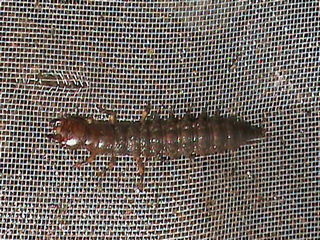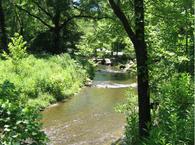
This course will familiarize the student with the basic baits, spinners, flies and artificail lures for fishing. The student will learn how to collect live baits and how and where to use them to be most effective.
Natural Baits - Using live bait is perhaps the easiest way to catch fish. Generally, you will want to use a swivel on your line to prevent twist when using live bait. Live worms, especially nightcrawlers, are a good choice for the beginner, although other types of worms can be used effectively. Use a small short shank hook, perhaps #8 or #10, and insert it under the darker band on the worm. It may be necessary in the more swift waters, to add a small split shot about 12" to 14" above the hook to carry the hook to the bottom of the stream. However, if that is not necessary to reach the bottom, it is advised not to use the weight, as it is another componebnt to get snagged on the bottom. Then cast the worm into any pool with a preference given to the head waters of the pool. The worm can be retrieved at a slow constant speed or it can be jiggled by steadily raising and lowering the rod tip. For shallow water, start by using a small bobber (foam or cork bobbers are preferred to plastic ones on rocky streams), 2’ – 3’ above the hook. You may then want to remove the bobber and/or add small split shot weights to the line, if the water is deeper.
The best live bait, in our experience, is hellgrammites. These larvae are collected from a river or stream, are very hardy, and they are a favorite of the fish (not just trout). Some states do not allow the collection of bait in a trout stream, so you would have to collect the hellgrammites in another river. We collect our own hellgrammites by using a garden implement known as a potato hook. We look for large flat rocks in rapid flowing water that is approximately 10 inches to 20 inches deep. About 3-4 feet downstream from the rocks, have someone hold a section of window screen on the bottom of the stream, such that the water flowing down will necessarily flow thru the screen, filtering out any object in the flow. Hook the times of the implement under the rock, pulling it up and out of the way. Then, briskly scratch the floor of the stream. After the water clears, inspect the screen for your catch, if there are hellgrammites, hold the back of the hellgrammites’ head between your index finger and thumb, not allowing their head (with pinchers!) to turn and pinch you. Hook the hellgrammites such that the hook point goes in one side of the hard shell behind their head and comes out the other. Note: Hellgrammites can swim and crawl, and as such can easily get the hook caught under rocks, on logs, etc., causing you to lose your hook and bait.
Additional live bait can be collected or purchased, including crayfish, other types of worms, crickets, grasshoppers, etc. They can be fished in similar fashion to worms, though worms and hellgrammites are hardiest baits. I have seen a piece of bread rolled into a dough ball; and that can be used as bait for hatchery supported fish. However I have no idea if dough balls are effective on wild trout.
Do not use exotic (i.e. baits not already living in the body of water you are fishing) minnows or other baits on trout waters. This practice could disrupt the ecology if they were to escape and survive in the trout stream. Note: Some states do not allow the collection of bait in a trout stream.
Other effective natural baits (though not exactly "live") include corn (from a can) and salmon eggs. Samon eggs can be live or from Berkley. These can be placed, several at a time, on a hook. Weight the line with several split shot, depending on how deep/swift the water is, to get the bait to the bottom. Keep a hand on the line/watch the line at all times to detect subtle strikes.
Spinners - In Line Spinners are probably one of the easiest to use and most effective artificial lures is a spinner. Spinners are small lures that have a blade that revolves around a shaft as the lure comes through the water. They come in a variety of sizes and colors. Generally, black, white, brown or yellow are good choices for the body of the lure, and silver or gold for the blade. The best sizes to use are from 1/16 oz. (for tiny streams) to 1/8 oz. (the most versatile size), up to ¼ oz. (for use on the largest streams). As you fish with a spinner, be sure you retrieve it fast enough to cause the blade to revolve around the shaft.
Lures - There are several varieties of floating and sinking lures intended to imitate the movements of live bait. The Rapala line of lures imitating small fish is a good example of these. These can be floating or count down. Other, less common, lures include crankbaits, spoons, jigs, and plugs that resemble minnows.
Flies - Dry flies usually imitate terrestrial insects (i.e. insects that live on land, such as ants, bees, grasshoppers, etc.) or the adult versions of aquatic insects that have risen to the surface to fly away. They are allowed to float on the surface with the current as you fish them, and as such, are probably the easiest and most fun to fish with. Wet flies usually imitate an aquatic insect that is under the surface of the water, rising to the top to fly away. These, along with nymphs (discussed below), are probably the most difficult to fish, since you often cannot see them, and the fish’s strike can be subtle. Wet flies are allowed to drift in the current under the surface of the water. Nymphs usually imitate the immature stage of an aquatic insect’s life in which the insect lives in the water. They can be fished with various amounts of weight on the leader to keep the fly in the same depth of water the fish are holding in. Often, a small strike indicator (think of it as a small bobber), usually red or orange, is attached to the leader to allow subtle strikes by the fish to be detected. Nymphs are also allowed to drift in the current under the surface of the water. Streamers usually imitate minnows, or sometimes other, larger bait such as crayfish. They can be fished with weight on the leader, if necessary, to force them to ride lower in the water. Streamers are forced through the water by pulling the fly line with your hand, (carefully) letting the line accumulate in the water at your feet, ready for the next cast. Note:When using fly line in a stream, try to keep as much of the line out of the water as possible, to avoid the effects of drag on the line. For example, if your fly lands in still water, and your fly line lands in fast water, the line will be moving faster than the fly to the extent that it will eventually pull the fly through the still water.
Study the basic flies.
The Orvis Fly-Fishing Guide, A best-selling, fully illustrated, and comprehensive book, this large-format volume has been required reading for every angler for the past two decades.
Recommended Instructional DVDs:
Stone Flies Imitating Aquatic Insects
Mayflies -Fly Tying Guide to Imitating Aquatic Insects
Recommended Reading:
Essential Trout Flies
By Dave Hughes
How to tie the 31 most effective trout patterns and selected variations-more than 200 recipes in all. Step-by-step color photos and fishing notes "Essential Trout Flies" will help you assemble, in just two fly boxes, the flies you need to catch trout anywhere.
North Carolins & Georgia Hatch Chart This chart lists the hatch and the





